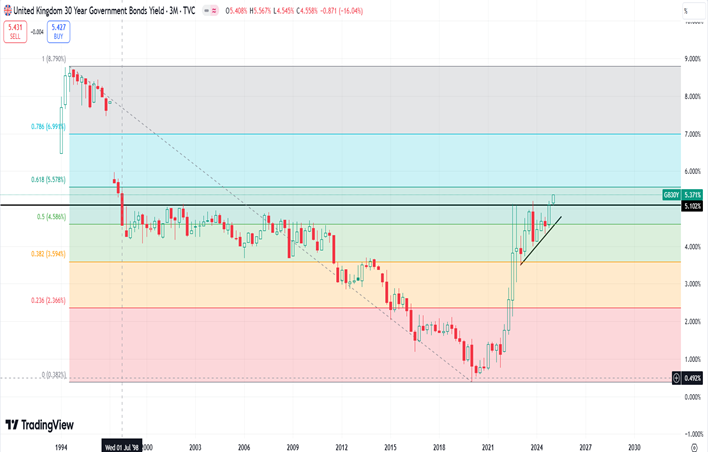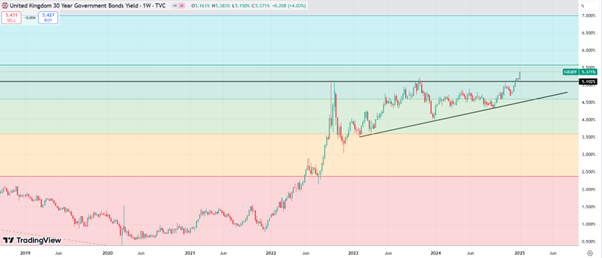UK 30 Year GILT Yield
09/01/2025
As of January 8, 2025, the yield on the UK’s 30-year government bonds, also known as gilts, has surged to around 5.25%, the highest level since 1998. This sharp rise in long-term borrowing costs is reflective of broader economic pressures and investor sentiment. A combination of domestic and global factors has led to this spike, which is having significant consequences for various sectors of the economy.
One of the key reasons for the increase in gilt yields is a lack of confidence in the UK government’s economic management. Investors are demanding higher returns to compensate for perceived risks, given political and fiscal uncertainties. The UK has faced several challenges in recent years, including ongoing debates around fiscal policies, public spending, and tax hikes, all of which have contributed to doubts about the government’s ability to manage the country’s finances effectively. This lack of confidence has pushed long-term borrowing costs to their highest levels in over two decades.
Furthermore, there is speculation that the Bank of England may intervene to curb the rising yields. The Bank has already played a key role in managing interest rates over the past years, but the current environment of high inflation and slow economic growth has left it with few tools to combat the rising cost of borrowing. Despite this, it is possible that the Bank may step in with measures such as quantitative easing or interest rate cuts, although the effectiveness of these interventions remains uncertain in the current climate.
The rise in long-term borrowing costs is having a profound effect on the housing market, with mortgages becoming increasingly unaffordable for many homeowners. Higher gilt yields lead to higher mortgage rates, which in turn make homeownership more expensive, particularly for first-time buyers. The cost of servicing mortgages has already become a significant burden for many households, and this trend is expected to continue as bond yields stay elevated. For potential homeowners, the dream of owning property is becoming more difficult to attain, exacerbating the housing affordability crisis.
In this context, the Bank of England’s next steps will be crucial in determining the trajectory of UK borrowing costs and their broader economic impact. The current trend of rising yields is likely to continue unless there is a change in fiscal policy or a concerted effort by the Bank to address the root causes of the economic uncertainty.

Source: TradingView – UK 30 Year Government Bonds, 3 Month
The chart above illustrates the yield on the 30-year GILT from 1994 to the present day.
This chart is presented on a quarterly basis, with each candle representing three months of yield data. Currently, the yield stands at 5.37%, marking the highest level since 1998. This significant increase exerts considerable pressure on the government’s long-term borrowing costs.
Additionally, the weekly chart below highlights the recent breakout of a key resistance level at 5.10%, emanating from an ascending triangle formation. This pattern is typically indicative of trend continuation, suggesting that long-term rates may, if the prevailing trend persists, reach as high as 7.2%.

Source: TradingView – UK 30 Year Government Bonds, 1 Week
This rise in yield is a clear indication of the broader economic pressures and investor sentiment impacting the UK market. The government’s ability to borrow at sustainable rates is being challenged, and this trend is likely to have far-reaching consequences across various sectors.
The Bank of England’s role in addressing these challenges will be pivotal. Measures such as quantitative easing or interest rate adjustments may be necessary to mitigate the economic impact. However, the effectiveness of these interventions in the current high-inflation, low-growth environment remains uncertain.
In summary, the elevated gilt yields reflect a combination of domestic and global factors, underscoring the need for strategic economic management and intervention to stabilise the market and ensure sustainable borrowing costs.





